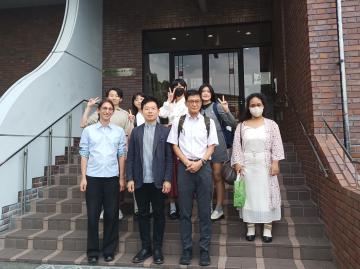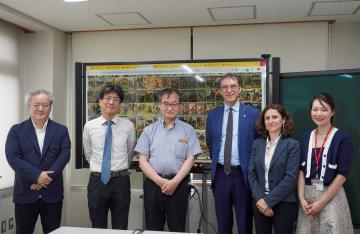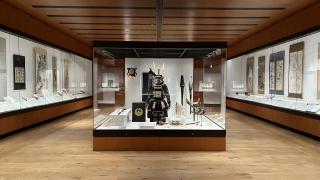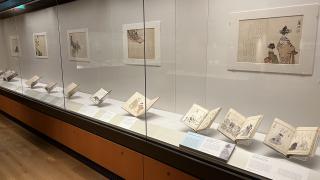-
[イベント情報]July 3, 2024(Wed)
On July 3, 2024, Prof. Giovanni Molari (Rector, Bologna University) and Raffaella Campaner (Vice Rector for International Relations, Bologna University) visited the Art Research Center (ARC).
Besides a tour of the ARC building and facilities, discussions and an exchange of opinions on collaboration in digital humanities research and education took place with Prof. Ryo Akama (College of Letters/Director of the ARC).
[イベント情報]July 3, 2024(Wed)The 136th International ARC Seminar will be held as a webinar on Wednesday, July 3, from 18:00 JST.
The program is as follows:
Speaker: Mamiko ISHII (Professor, Chinese Literature and Throught Major, College of Letters, Ritsumeikan University)
Topic:「Gion Festival and Chinese Classical Literature」
Date: Wednesday, July 3, 18:00 - 19:30 JST
Participation: online via Zoom, free of charge (affiliated parties only, no reservation required)
*This is a closed event and YouTube livestream is not available.
[イベント情報]June 26, 2024(Wed)The 135th International ARC Seminar will be held as a webinar on Wednesday, June 26, from 18:00 JST.
The program is as follows:
Speakers:
Tatsuki MACHIDA (Associate Professor, Faculty of Human Development, Kokugakuin University)
Yuji KURIHARA (National Museum of Nature and Science)
Sachiko NIINA (Prince Chichibu Memorial Sports Museum and Library)Topic: Japanese Sports Archives for Passing Knowledge to Future Generations (「日本のスポーツアーカイブを未来へと継承するために」)
Date: Wednesday, June 26, 18:00 - 19:30 JST
Participation: online via Zoom, free of charge (affiliated parties only, no reservation required)
*This webinar is open to everyone, and non-ARC members are invited to participate via YouTube.

On June 20, 2024, a group of students and faculty members of National Chengchi University, Taiwan, visited the Art Research Center (ARC).
Besides a tour of the ARC building and digital archiving facilities, Dr. Travis Seifman (ARC Research Manager/Associate Professor, Kinugasa Research Organization, Ritsumeikan University) gave an introductory presentation on the DH research activities of the Center.
[イベント情報]June 21, 2024(Fri)We are pleased to announce the second Joint Colloquium 'Japan Researched from the United States, and Japan Studies Research Communicated to the World,' co-organized by the Center for Japanese Studies (CJS), University of California, Berkeley, and the Art Research Center (ARC), Ritsumeikan University on June 21, 2024.
Date: June 21 (Fri), 2024, 14:00-17:30 JST
Venue: Art Research Center (ARC) + online via ZOOM (※This is a non-public event.)
This colloquium is supported by the International Joint Digital Archiving Center for Japanese Art and Culture (ARC-iJAC), Art Research Center, Ritsumeikan University.
Program (tentative)
Read more>>[イベント情報]June 12, 2024(Wed)The 134th International ARC Seminar will be held as a webinar on Wednesday, June 12, from 18:00 JST.
The program is as follows:
1. Speaker: Kohei KONO (Professor, Department of Social Sciences, College of Humanities and Social Sciences, Ibaraki University)
Topic: On the 20th century television commercials database (「20世紀のテレビCMデータベースについて」) (in Japanese)
Date: Wednesday, June 12, 18:00 - 19:30 JST
Participation: online via Zoom, free of charge (affiliated parties only, no reservation required)
*This is a closed event and YouTube livestream is not available.
As one of the ways to support the activities of international joint research projects, the Art Research Center (ARC), Ritsumeikan University, provides ArcGIS Online accounts that can be used with the GIS platform ArcGIS, a web-based mapping software of Esri, Inc. Members of international joint research projects can use the accounts issued by the ARC under the conditions as stated below. If you wish to use the account, please contact us at ml-tech-support[ at ]ml.ritsumei.ac.jp (replace [ at ] with @). Please state as the subject of the email 'Request for ArcGIS Online account' and include 1. full name, 2. registered project name, and 3. email address in the email.
- Researchers who are registered in an international joint research project (including co-researchers and graduate students).
Note: If you have not yet registered for an international joint research project, please first submit an application for International Joint Research to Utilize the Center's Facilities and Equipment [D]. If the purpose of your project is related to educational purposes, please apply for International Joint Research to Utilize the ARC System for Educational Purposes [E]. →Click here for details.
- One account will be issued per person.
- Each user can use 250 credits. Please contact us if you wish to use more.
- The account must be renewed each fiscal year.
- If the maximum number of registrants is reached, we may not be able to issue accounts or continue the use across fiscal years, even if an application is received.[イベント情報]May 22, 2024(Wed)The 133rd International ARC Seminar will be held as a webinar on Wednesday, May 22, from 18:00 JST.
The program is as follows:
1. Speaker: Akihiko TAKANO (Visiting Research Professor, Kinugasa Research Organization, Ritsumeikan University)
Topic: Creating Platforms for Discovery Learning using Digital Archives (「デジタルアーカイブを用いた探求学習のための教材作成について」)
Date: Wednesday, May 22, 18:00 - 19:30 JST
Participation: online via Zoom, free of charge (affiliated parties only, no reservation required)
*This webinar is open to everyone, and non-ARC members are invited to participate via YouTube.
[イベント情報]May 20, 2024(Mon)The Art Research Center (ARC), Ritsumeikan University, is pleased to announce the release of a Database for Browsing Materials and a Material Retrieval System for the Shuichi Kato Collection held by the Ritsumeikan University Library.
The Shuichi Kato Collection Database for Browsing Materials
https://www.dh-jac.net/db1/resource/search_2023i05.php?lang=enThe Shuichi Kato Collection Material Retrieval System
https://www.dh-jac.net/db1/resource/search_KSB2023i05.php?lang=enShuichi Kato (1919-2008) was one of the leading international intellectuals in post-war Japan. He studied the history of Japanese art and literature based on his extensive knowledge and broad perspective that spanned Western and Eastern cultures.
Established in 2015, the Research Center for Shuichi Kato and the Japanese Contemporary Thoughts aims to research the vast number of books and manuscripts in the Shuichi Kato Collection of the Ritsumeikan University Library, disseminate and utilize the knowledge gained through this research, and foster international intellectuals.
Developed by the ARC, the Shuichi Kato Collection Database for Browsing Materials and the Material Retrieval System serve to further enhance online research activities.
Related links:
Research Center for Shuichi Kato and the Japanese Contemporary Thoughts: https://en.ritsumei.ac.jp/research/organizations/research-center-contemporary-thoughts/
The Shuichi Kato Collection: https://www.ritsumei.ac.jp/lib/b07/020/
[イベント情報]May 9, 2024(Thu)The Art Research Center (ARC), Ritsumeikan University, is pleased to announce that a one-year Special Display at the British Museum in London is currently showcasing the research outcomes of the international joint research project 'Creative Collaborations: Salons and Networks in Kyoto and Osaka 1780-1880 (上方文化サロン:人的ネットワークから解き明かす文化創造空間 1780-1880),' supported by UK Research & Innovation (UKRI) and the Japan Society for the Promotion of Science (JSPS).
This research project, led by the Principal Investigators (PI) Prof. Ryo Akama (Director of the ARC/College of Letters, Ritsumeikan University) and Dr. Akiko Yano (Curator, Department of Asia, British Museum), aims to investigate the cultural and social impact of art and literary salons and the collective creation of art (gassaku) in early modern Japan, particularly in the Kyoto-Osaka region circa 1780-1880 by analysing over 5,000 objects in collections at the British Museum and in Japan.
During the course of this project, these works have been digitally archived and their textual inscriptions transcribed into an extensive online research database--the 'Kamigata Bunkajin Sogo Database' (「上方文化人総合データベース」)--established and operated by the ARC, providing a new portal for research on early modern Japanese culture with the possibility of incorporating other collections on different themes in the future.
→ARC Virtual Institute: Salons and Networks in Kyoto and Osaka
Addressing the challenges presented by COVID-19, the project has been exemplary in how a Japan-UK collaborative research project, comprised of a team of researchers from the Art Research Center (ARC), Kansai University (KU), the National Museum of Modern Art, Kyoto, the British Museum (BM), and SOAS, University of London, can be conducted efficiently using digital online technologies for remote collaboration.
The project has also fostered early-career researchers in Japanese studies by providing an opportunity for them to gain hands-on experience in the fundamental aspects of digital humanities within an international research environment.
This project was supported by the JSPS International Joint Research Programme (JRP-LEAD with UKRI) [JPJSJRP 20211708].
Project duration: December 1, 2021 - November 30, 2024 (3 years).
Related article: https://www.britishmuseum.org/research/projects/making-art-together-japan
Read more>>
















